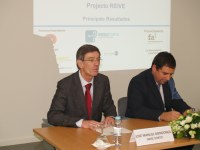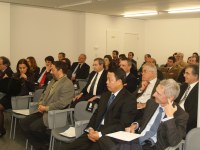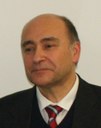Conclusion of project REIVE: INESC TEC is world leader in Smart grids
Laboratory of Microgrids and Electric Vehicles is pioneer in the country
On 20 December, INESC TEC marked the conclusion of one of the most symbolic projects at INESC TEC led by the Power Systems Unit (USE), and involving also INESC TEC’s Telecommunications and Multimedia Unit (UTM) and the R&D partners LNEG e o CEEETA-ECO. Project REIVE (Smart Grids with Electric Vehicles), which started almost three years ago, brought a research component to the Associate Laboratory with industrial objectives and a unique laboratory component associated to electric mobility. At the project’s closing session, some of the partners had the opportunity to visit the laboratory and to see first-hand how the equipment works.


Laboratory can reproduce a “Smarthome”
The Laboratory of Microgrids and Electric Vehicles is a unique infrastructure in the world and places Portugal at the forefront of smart grids worldwide. Provided with an experimental component that is unique, this laboratory makes it possible to test, in an environment that is very close to a real environment, new solutions that integrate microgeneration units and electric vehicles in Low Voltage grids.
According to Luís Seca, adviser to the manager of USE, “the laboratory’s differentiating feature is its capacity to control and configure a system that can replicate a low voltage power grid. Furthermore, the lab contains distributed renewable resources and electric vehicles. Such a system can reproduce what can be a house of the future, the so-called ‘Smarthome’, where the end client plays an active role in managing the power grid using the interfaces that were developed as part of the project”.


Furthermore, the laboratory is also extremely useful to the national industry, particularly for companies that develop and integrate power systems, as well as energy-related technology manufacturers, as they can benefit immensely from the structure to develop and test their own innovative solutions with potential for export.
The laboratory includes a set of smart inverter prototypes to control microgeneration (solar photovoltaic and micro-wind power) and electric vehicle batteries (bidirectional) which can adapt autonomously to the needs and limitations of the power grid.


The equipment to measure and analyse the grid, as well as different communication solutions developed and installed at the lab (communication networks, modules for adaptation between technologies, intelligent graphical interfaces for interaction with users) will open new opportunities for industry. If on one hand it is possible to transfer these innovative results to industry, it is also possible to use the infrastructure for testing and to develop new consulting services. These can be exploited not only by companies seeking to develop smart grid related products, but also network operators that want to integrate new products in their services.
Laboratory responds to the EU energy goals
The Laboratory of Microgrids and Electric Vehicles represents a step ahead in national research and, at the same time, it meets the challenges set out by the EU for the Energy-Climate package as it integrates the 20-20-20 goals, which require a decrease in C02 emissions and Electric Power Systems to become more efficient.


Over the last decade, INESC Porto, particularly USE, has been contributing to the development of a smarter and more active distribution network by participating in European projects, such as INOVGRID, MICROGRIDS, MORE-MICROGIRDS, MERGE and REIVE. “Developing a laboratory for electric mobility and microgeneration is key for transferring the research results to industry”, argues Carlos Moreira, a researcher at INESC TEC.
The lab has already begun to take the first steps towards internationalisation. INESC TEC has recently joined the network DERLab - European Distributed Energy Resources Laboratories, a European reference for the sustainable integration of distributed energy resources in power systems. This association aims to promote forms of producing energy which are more environmentally sustainable, and to exchange of information and scientific visions, as well as train its members, and organise events for technology transfer in this area.


Next year the focus will be on how to manage consumption intelligently
The Laboratory of Microgrids and Electric Vehicles includes an interdisciplinary team involving different areas of knowledge, including Power Systems, Power Electronics and Communication Systems, and Information Technology. For this last aspect, the collaboration of INESC TEC’s Telecommunications and Multimedia Unit (UTM) was key.
Soon the team will be reinforced with PhD students, who will be developing new intelligent management features for consumption targeting the consumer. The project kicked off in 2010 and involved a total investment of 2.6 million Euros, funded by the FAI (Innovation Support Fund) and industry partners (EDP Distribuição, EFACEC, Logica and REN). The project was also supported by the CONTAR and Galp Energia. The laboratory infrastructure also received financial support from the NSRF’s (National Strategic Reference Framework) ON2 programme.
Have Your Say

Pedro Cabral - Directorate General for Energy and Geology (DGEG)
“These support mechanisms for innovation and development in the energy sector must be increasingly enhanced so that they might be used in the future, since they make it possible to ease the burden of the services’ final cost”.

Teresa Ponce de Leão - National Laboratory of Energy and Geology (LNEG)
“Project REIVE is an outstanding example. It was important for us to be associated with this project. We should create an alliance in Portugal for energy as that would greatly benefit our country."

João Peças Lopes – INESC TEC
“The laboratory confirms the excellence of the work developed over the last decade by INESC Porto's Power Systems Unit (UTM). As a result, the Unit can stand out as an entity that can go from applied research to products and solutions which can be integrated in the market. This success will necessarily bring greater credibility to the institution that will continue to asserting itself as a European reference in power systems”.

José Ruela - INESC TEC
“Project REIVE confirmed (namely during the lab’s designing, installation, testing and operation stages) the enormous importance and the fundamental role that communication solutions play in the context of smart grids. We expect that the convergence of interests between the two INESC Porto Units involved in this project (USE and UTM), which have already collaborated in other projects (Microgrids and Inovgrid), will be strengthened in the future, using the platform created as the fundamental basis. It is also important to highlight the strategic value that this laboratory can have to the national industry, using the combination of the energy and telecommunications areas as a key strategy.”
Go on a guided Tour to the Laboratory of Microgrids and Electric Vehicles here


